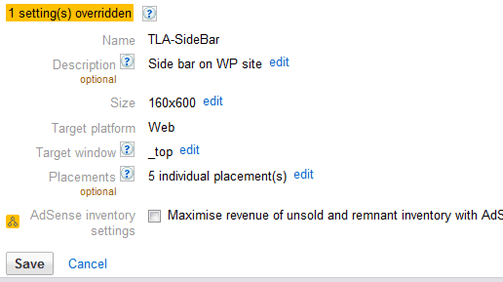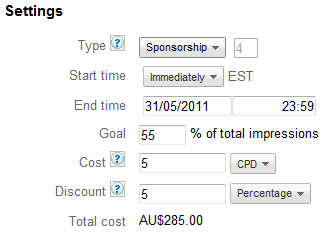This post seeks to touch on another free Google platform provided that seeks to reduce your reliance on just Google AdSense or Affiliate banners for publishers revenue and offers you some cool little features to maximise profits. The platform DFP Small Business just requires you to have a google AdSense account to get started and the ability to add a few javascript tags to your website and that’s where the fun starts.
How does DFP Work?
The first point to understand is that each space on your website is classed as an “ad unit” and the ads are controlled by placement of an “ad tag”. A placement is a group fo related ad units that you can sell to advertisers or group associated ads. To create a new creative you create an unique “order” which you enter line information detailed in the next paragraph.
Types of Line Items
Sponsorship – sell a % of all impressions with highest priority of delivery Standard – sell a fixed quantity of impressions via CPM or CPC Network – sell a % of remaining impressions suitable for ad networks Bulk – allocate fixed quantity of remaining impressions Price Priority – remaining impressions go to highest paying ads House – serves when no other ads are booked and can run a percentage of remaining impressions.

What line item suits who?
Sponsorship is typically the most common for placement buys or when starting out with a few affiliate programs. Standard line items are suitable for publishers who sell to individual advertisers or who have a higher turn over of advertisers each month. Network and Bulk are typically better suited to higher traffic sites that may not be able to sell all their space and are happy with any extra revenue as it’s cream on the top. Price Priority are suitable for last minute advertisers who maybe willing to pay a premium for exposure for a breaking news or exclusive piece of content you have on your site. House is suitable for internal promotions such as FB like buttons, twitter feeds, email sign-up forms or self promotional messages.
How does DFP and AdSense work?
Because you can change the line items you can adjust the value of the creative CPC or CPM, DFP will focus on showing the item that generates the most revenue for the publisher. The interesting point is that you can automatically show AdSense on any unsold or remnant inventory when you create a new ad unit and will show instantly across any active ad units. I advise to create an AdSense placement using the DFP interface to copy existing AdSense targeting and use known AdSense banners that perform as you retain more control and can show them less frequently.

Adjust Delivery for Best ROI
You can control how many creatives are shown, and how to rotate creatives with an optimised delivery based on best CTR which guarantees most revenue for you. To ensure higher ROI look at scheduling delivery based on day and time based on users or publishers time zone. If you know the affiliate program converts poorly over weekends select not to show the ads at that time, but if you see that AdSense earnings are much higher at certain times of the day elect to show AdSense banners only during those times.

Using platforms like DFP reduce opportunity cost
You don’t have to make a decision to sacrifice potential AdSense revenue in place of affiliate banners. You can even negotiate deals with affiliates that they will pay CPC only on the first 10 visitors, they only want to pay a CPM of $15 or they guarantee a set conversion rate within a window of time that you must monitor. You can easily set your line item to automatically stop and you can review that campaign data later so advertisers or affiliates don’t get a free ride.The other benefit is that DFP starts to gather data to help you forecast your traffic and potentially how much money you should be charging for ads.

Adjust the impact of banner blindness
Using features such as using multiple user frequency cap settings to set the maximum number of impressions your visitors will see from just minutes to a maximum lifetime option. You should be looking to show a mixture of variation of creatives for best ROI.
Inhouse Roadblocking
You can use platforms like DFP Small business to run several creatives together on the same page, so you can create a page takeover which reduce the impact of banner blindness. To make this work effectively you need multiple creatives as an individual creative can only be served once on a single pageview. To work effectively you need to match as many ad tags to as you have creatives in that line item you are delivering. ie 3 Ad Tags 3 Ad creatives
Maximise ad targeting
You can already link your AdSense revenue to your Google Analytics for better analysis and tag affiliate banners/links with event tracking for understanding revenue. The downside is that you have to login to multiple affiliate platforms to understand your true metrics but have to sometimes assume links between visitors and sales.
Management of Affiliate/AdSense Inventory
The problem is that you have a limited amount of time and resources and often have more advertisers wanting exposure than you have space on your site. The other issue is that you may have to sacrifice revenue to test new creatives or advertisers but using DFP you can automate the testing and reporting.
Improve matching of ads to content
While platforms like AdSense or Chitika can serve targeted solutions based on content and using custom tags to either exclude or show ads based on visitors pageviews of content within your site.
Example custom criteria tag
GA_googleAddAttr(“content”, “adwords”);

Sky is the limit with DFP tags
The true potential is that you can pass multiple values as DFP Small business supports up to 20 custom targeting criteria with each containing up to 200 values. While you can only use alphanumeric characters (incld -_+) each key can contain up to 10 characters. While you can also use free-form targeting but an individual key maybe only set to custom or free-form targeting but not both.
Geography
You can further improve your ROI by showing ads via countries, regions, DMAs and cities but also exclude locations if visitors are failing to click or convert. If you are running a travel affiliate program you can tailor the ad to the users location to improve clicks and conversion rate. If your affiliate refunds are high from a particular region of the world select to show AdSense or an affiliate that pays CPC.
User Domains
Using DFP features you can tailor your display ads to suit visitors ISPs so any staff from Google see AdSense and any staff from Microsoft see pubCenter ads. Looking at your AdSense data in Google Analytics you might discover that .edu visitors are more likely to click AdSense banners so you serve only serve them AdSense but any .gov visitors never click AdSense so you are limiting revenue and show try something else. A case example is that using DFP you can show all ISP visitors from AT&T your Verizon affiliate sign-up banners and vice-versa.
Visitor environment
If you know that based on your Google Analytics data or knowledge of affiliate website technical limitations how certain visitors using particular browsers, languages or operating systems behave you can tailor the ads. If your affiliate program has a Mobile version of their website send android visitors direct, or based on their browser language set to German send them to the German language version.
Next Level using DFP Small Business
While it is technical possible to use custom tags with some programming assistance to tag visitors from SEJ to not see any ads or even show SEJ banners promoting your previous posts. The potential to start to tailor messages based on referral URL or even keyword can allow you to have bespoken ad creatives matched for best ROI.
DFP Small Business kills SEO affiliate links
One of the biggest reasons that some people won’t push for the take up of DFP Small Business is that their affiliate links lose the link juice via a redirect so are potentially less valuable. The side benefit of using DFP Small Business to serve your affiliate banners is that you can guarantee that Matt Cutt’s won’t be calling you on cloaking affiliate links because DFP does it automatically.
But I would think for most publishers and advertisers the redirect element is a minor issue but the potential uplift in ROI for publishers and better transparency for advertisers makes it more acceptable for most.
Why you should consider using DFP Small Business?
Currently it’s not possible to request AdSense CPM ads for your site or only be paid by CPM but some advertisers or affiliates may offer this, but using an Ad serving platform you can easily scale up and run multiple ad types based on ROI.
If you are given a free platform to improve your earnings you should use it if you are doing it manually and continue to measure and improve your earnings. To sign up to DFP just apply via this link.





